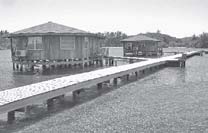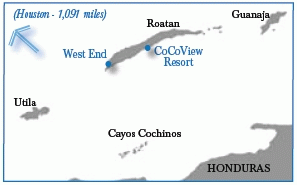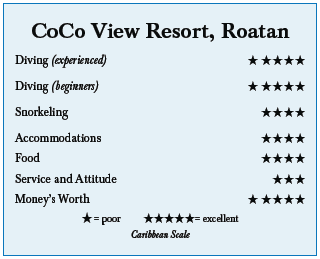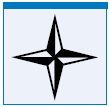CoCo View Resort, Roatan, HondurasContents of this Issue: CoCo View Resort, Roatan, Honduras Apeks and AquaLung Announce Regulator Recalls Introducing Our New Online Divers Forum The Finest Dive Boat in Papua New Guinea? Not Yet Cave Diver Gets Electric Shock Divers, Sign Your Life Away: Part I Are Your Dive Photos Worthy of a Book? Magic Beneath the Seas: Our Book Review Cayman Dive Operators Protest Safety Regulations Editorial Office: Ben Davison Publisher and Editor Undercurrent 3020 Bridgeway, Suite 102 Sausalito, CA 94965 hello Muddah, hello Faddah, here I am at... from the August, 2008 issue of Undercurrent
Dear Fellow Diver: Last spring, I chatted with my local dive shop owner about my upcoming April trip to Roatan. “Ah, CoCo View,” he reminisced. “You can really dive your brains out there.” Many Undercurrent readers confess to being “CoCo Nuts,” picking the dive resort as the one they’d likely return to. Eighteen dives later, I knew what they meant. It’s a full-throttle version of summer camp for divers. Every day was packed with boat dives, self-guided dropoffs, meals at the clubhouse and a few extracurricular activities crammed in between. Fellow guests, mostly Americans, were 20 to 50 years past summers at Camp Granada but as energetic and rowdy as kiddie campers. Our campground was bordered by undersea walls and filled with fish and critters -- especially macro life -- concentrated in a small area. I’m talking about Bonaire-level dive quality, but with walls on either side of your doorstep.
No need for “Reveille” on my alarm clock. I woke up at
daybreak. A quick breakfast at the main lodge followed by two
boat dives, lunch, two more boat dives, shore dive. Dinner
back at camp, then a night dive. Instead of s’mores around
the fire, I had nightcaps on my seaside porch. “Taps” was
the sound of waves lapping against the stilts of my overthe-
water bungalow. I didn’t pay all this money to have camp
counselors plan my
day, but CoCo View’s
dive schedule is as
hectic or relaxed as
you want it to be.
The seven-day packages
come with two twotank
boat dives per
day, and the ease and
freedom of self-guided
shore diving in the
resort’s “Front Porch”
meant I could spend
the entire day underwater.
As a first-timer, I had to submit to a checkout dive. Serious for a twentysomething, Honduran divemaster Mark watched his troop of newbies demonstrate buoyancy control and mask clearing. Then he led us on a shore dive through a narrow cut between grassy shallows to Newman’s Wall. Straight ahead at 65 feet was the wreck of 165-foot coastal freighter Prince Albert, with a DC-3 airplane just off its bow. Forty iridescent reef squid hovered over a sandy bowl nearby. The shallow cut was filled with snappers, grunts, damsel, squirrel and butterflyfish, perfect for snorkelers. On the way back, a pair of spotted eagle rays serenely glided past me, while a large southern stingray skated along the bottom. The resort is on its own palm-covered island, a 20-minute drive from the airport and a five-minute boat ride from Roatan’s southern end. I was ushered there by Nora, CoCo View’s friendly head counselor, who had greeted me at the airport. The resort consists of just a few wood-framed buildings, resembling fisherman’s boat shanties. Every bungalow, cabana and standard room faces the Caribbean and a small, sandy beach running round the island. I strolled the boardwalk connecting all rooms to the clubhouse, the dockside dive center, and Hawksbill Caye, a smaller island that used to house a turtle farm. Now it holds a thatch-roofed picnic area, the camp’s central meeting area where staff grilled up meals and some evening partying took place. I was happy with my spacious wooden bungalow with high ceilings, good bedside reading lights, two ceiling fans, and French doors framing the ocean view. The balcony had a hammock, two chairs and a little table good for lingering over sundowners. Air temps were in the low 80s and a steady 15 m.p.h. breeze blew the entire week, so nosee- um bites were sparse. I felt lucky when people kayaking over from Fantasy Island resort told me their beach was covered with blood-thirsty mosquitoes. The spartan bathroom had a smallish shower, no tub, and a toilet requiring three flushes to empty. The coffeemaker, fridge and bug bomb were handy. The AC worked fine, and there were 10 pegs for hanging gear. Some details were below par -- my coffeemaking supplies were never replenished, a dresser knob was missing, and bathroom walls were sloppily patched and unpainted. More “roughing it” moments came when the power went out two or three times daily -- I had to reset the A/C in the middle of the night when it went back to its default setting of 78 degrees, and I gave up on resetting the clock.
After a briefing accompanied by laminated illustrations, Mark guided 15 of us while Gringo, another twentysomething local divemaster who ironically spoke little English, stayed with the moored boat. Each boat went to a separate site, never repeating any. We were on a fixed menu and no one had input into the tightly choreographed locations -- it would have messed up logistics. When divemasters pointed out something interesting like a long-snout seahorse or a large-eye toadfish, a long line of divers waited, or if hysteria set in, a mass of bodies crowded in. Annoying, but it didn’t happen that much. There was an occasional rare fish or creature, but most dives took place on undramatic reef structures. Calvin’s Crack was the most visually memorable. After an unassuming approach, I entered a small, dark tunnel, a narrow crack in the reef. On the outer wall, cathedral-like beams poured in from 60 feet above. Elegant spotted drum danced about the barrel-sized sponges clinging to the wall on the other end. A grumpy, large-eye toadfish squatted on a shallow plateau. While the first boat dive was an appetizer, the second tank, both morning and afternoon, was a good main course. I’d giant stride into the 80-degree water, either at CoCo View Wall or Newman’s Wall, for a leisurely, unguided dive back to CoCo View’s beach. My first drop-off was the most exciting because I had no idea how far away from the resort I’d been dropped. As my air supply fell, I wondered whether I could go the distance without a surface swim. After dropping to 50 feet, I gradually glided up to 25 feet. Checking me out along the way were an arrow blenny hugging soft corals, a peppermint goby perched atop a magnificent brain coral, and a raggedy decorator crab clinging to a gorgonian. I stood up in the cut 72 minutes later, welcomed back to the “front porch” by Caribbean reef squid flying in formation. On further dives, I averaged 45 to 60 minutes, photographing cryptic teardrop crabs and secretary blennies at my leisure, with visibility of 75 feet. Still, the boat dives were the only place to see a different cast of fish, varied swim-throughs and stately reef canyons. The dive setup was well laid out. Ample bins, showers and clotheslines, camera and rinse tanks, were just steps away from the stern of the boat. On each bin, I hung a tag with my room number if I wanted to do a boat dive, so the crew took my gear and set it up on the boat. Whenever I wanted to shore dive, I just took an aluminum 80 from a rack of tanks, all filled to 3000 psi. A full-service dive shop was steps away. I took a photography lesson from award-winning Tim Blanton, who has a photo shop on premises. Patiently and with good humor, Tim taught me how to use ambient light and reduce backscatter from my flash, although he didn’t get into the water with me. But after three hours of lessons over two days, I was able to capture shots using a beautiful natural light, making the water virtually disappear from view. With a strong current flowing one morning, I drifted along the sloping dropoff at Connie’s Dream. I never dive openwater without a good safety sausage but noticed few divers here did the same. After working from 75 to 50 feet, I spent the last 25 minutes drifting above ridge after ridge of sponges, soft corals, and common reef fish. When my two buddies and I decided to surface, I lent them my safety sausage, which came in handy because it took 10 minutes for the boat to come. Another diver told me that when her group surfaced, there was no boat in sight, as it had left to pick up snorkelers who had drifted away. The divers had a nervous 10 minutes, waiting while trying to keep their heads above four-foot swells. While there’s no shopping or dining district nearby, CoCoView brought in a different local craft merchant every day. I took a half-day island tour on an air-conditioned bus (a bargain at $25). I hand-fed prehistoric-aged lizards at Arch’s Iguana and Marine Park, then strolled three acres of exotic jungle plants at Carambola Garden Center while golden spiders watched me from six-foot-wide webs hanging from the trees. Last stop was West End, a colorful town on Roatan’s north side where dive shops, bars, restaurants and European backpackers thronged lumpy dirt roads. I also took a 45-minute ride in an open cockpit float plane ($125). Sitting behind the pilot in the open cockpit with the wind in my face, we circled Roatan’s east end, never going above 700 feet, and got a birds-eye view of the resort- and reef-fringed shoreline. Buffet meals served in the central hall were all-American comfort food. Plenty of orange juice at breakfast to wash down any-style eggs with bacon or sausage, cereal and fruit. Lunches ranged from cheesy macaroni and roast beef sandwiches to chicken salad and shrimp soup. My favorite dinner entrees were garlic shrimp, calzone, and BBQ chicken and ribs. Sweet, moist Tres Leches cake and coconut bread made fantastic desserts. Except for one free beer, it was $2 for local beers like Salva Vida and Barena, $3.50 to $5 for mixed drinks and $3.75 for house wine. I kept my tab down by buying duty-free on the way in. My favorite staffer was Rebecca, a buoyant buffet-line server, who piled my plate high with a wink and a smile. While employees were friendly, they didn’t mingle with guests and stuck to themselves at meals. The Caribbean version of campfire took place nightly at Hawksbill Caye. One night, Doc Radawski, who started CoCo View’s dive operation, gave an overview of Roatan’s history, reefs and marine life. Next was fire twirlers lighting up the dark. Then it was young dancers in local costume doing a series of traditional numbers and pulling people from the audience for a lively spin around the floor. The high point was the limbo contest, fueled by free rum punch, which pretty much got everyone out of their seats. The two-story clubhouse sports ping-pong and pool tables, and its two computers offer free high-speed Internet. A good place for downtime was in the reading room/lecture hall, where rocking chairs on the open-air veranda offered great views. Midway though my trip, I decided to go for a six-dive day. At 5:50 a.m., I waded into the water with my dive buddy, spotting a brown mantis shrimp scurrying in the shallows plus a mottled jawfish before even reaching the Front Porch. I was clean and washed for breakfast at 7 a.m. Stern-faced divemaster Mark alerted me to a spotted moray and black-spotted nudibranch on the boat dive at Nerlyn Front Porch. I jumped in for the drop-off at Newman’s Wall and a mellow 65-minute underwater swim back. On the way, a bridled burrfish the size of a football used my body for cover. After lunch of boiled shrimp and chicken salad, I dropped into Forty Foot Point at 2:16 p.m., where Mark pointed out a longsnout seahorse. Strong wind and four-foot waves swept up a moderate current. A hundred horse-eye jack met me on a hard kick back to the boat. This is when their no-glove policy got annoying because to avoid being swept away at the safety stop, I cut my finger holding onto an encrusted mooring line. On the second drop-off at Newman’s Wall, I enjoyed the sight of secretary blennies darting out of their holes on the encrusted rail of Prince Albert’s foredeck. After a dinner of fried calamari, roast beef, and buttered coconut bread I was up for my night dive. They’re all self-guided shore dives, (there was one boat dive scheduled during my week for $35, but rough seas scuttled it). I signed in and out on a numbered log sheet and took a corresponding numbered tag. As the first diver out, I took a bright strobe light (provided by CoCo View) and hung that and my tag on a chain suspended at the end of the cut. Subsequent divers hang their tags and the last to shore returns the strobe. A search is launched if all tags and strobe are not back by 11 p.m. It was already dark when my buddy and I submerged at 8:30 p.m. and headed for CoCoView Wall. A fish the size of a goliath grouper loomed like a big boxcar in the darkness, just out of ID range. Tigertail sea cucumbers roamed, and a tank-like Spanish lobster lumbered across the bottom. On the way back up the cut, the waves foaming in the shallows created a strong, short rip current pouring back out to sea against us. I had to use my knife to anchor and pull my way through the swiftest part. As we left the water and hung up our tags, we shook hands on a great ending to a frantic fun-filled day. No marshmallows nearby to toast, so I settled on a sundowner and deep sleep. It’s obvious why people go cuckoo for CoCo View. It’s a fantastic place for hanging underwater with multiple types of reef fish and macro critters for four-plus hours a day. My fellow guests’ exuberance made me appreciate the great diving even more. Because of so many repeat visits by fans, reserve one of the 26 rooms at least 12 months ahead of time. When I first called, all of the bungalows and over-the-water cabanas were booked a year in advance by a single dive group. But CoCo View says that if rooms aren’t available for all the dates needed, they’ll book you into the Playa Miguel Beach Houses next door until a room opens. Sounds like a good deal, getting an oceanfront house for the cost of a hotel room, but not all have A/C and there could be a wait list for those, too. Getting into this dive camp can be as hard as getting the kids into private school, but the payoff is excellent Caribbean wall diving. -- S.P.
|

I want to get all the stories! Tell me how I can become an Undercurrent Online Member and get online access to all the articles of Undercurrent as well as thousands of first hand reports on dive operations world-wide
| Home | Online Members Area | My Account |
Login
|
Join
|
| Travel Index |
Dive Resort & Liveaboard Reviews
|
Featured Reports
|
Recent
Issues
|
Back Issues
|
|
Dive Gear
Index
|
Health/Safety Index
|
Environment & Misc.
Index
|
Seasonal Planner
|
Blogs
|
Free Articles
|
Book Picks
|
News
|
|
Special Offers
|
RSS
|
FAQ
|
About Us
|
Contact Us
|
Links
|
3020 Bridgeway, Ste 102, Sausalito, Ca 94965
All rights reserved.


 On a couple of days, I squeezed in onshore sightseeing to
keep my non-diving buddy happy.
On a couple of days, I squeezed in onshore sightseeing to
keep my non-diving buddy happy. Those are small issues for the
happy campers coming back for return
visits. Half of the divers who arrived
when I did had stayed there before.
My two main dive buddies had visited
eight and 15 times respectively. What’s
camp without a clanging bell? Dive shop
staff clanged it at 15, 10 and 5 minutes
before sending out the four 50-
foot boats at 9 a.m. and 2 p.m. Entry
was by giant stride off the sides or
back, reboarding was by two stern ladders.
The boats, originally built for
the U.S. Navy, had a boarding ladder
mounted in the center of the keel. The
captain swung it down through a large
box open at the top to admit returning
divers. Excellent for rougher seas
because it bucked a lot less than the
stern ladders, and I tried it once when the winds whipped up four-foot
waves during boat dives. Diving in
the shallower reefs meant fighting
with surge.
Those are small issues for the
happy campers coming back for return
visits. Half of the divers who arrived
when I did had stayed there before.
My two main dive buddies had visited
eight and 15 times respectively. What’s
camp without a clanging bell? Dive shop
staff clanged it at 15, 10 and 5 minutes
before sending out the four 50-
foot boats at 9 a.m. and 2 p.m. Entry
was by giant stride off the sides or
back, reboarding was by two stern ladders.
The boats, originally built for
the U.S. Navy, had a boarding ladder
mounted in the center of the keel. The
captain swung it down through a large
box open at the top to admit returning
divers. Excellent for rougher seas
because it bucked a lot less than the
stern ladders, and I tried it once when the winds whipped up four-foot
waves during boat dives. Diving in
the shallower reefs meant fighting
with surge. Diver’s Compass: A seven-day all-inclusive dive package starts at
$849 during low season, ending January 16 (excluding Thanksgiving and
Christmas weeks), then starts at $1,099; that doesn’t include a 16
percent room tax. . . A suggested 15 percent gratuity is spread among
the staff, but I tipped my divemaster and captain $5 each per boat
trip . . . Nitrox is $8 per tank or $125 per week . . . CoCo View
asks to keep guests’ passports in their safe, which was fine with me
because my room’s wooden lockbox was rickety . . . Direct flights
to Roatan run through Houston (Continental) and Atlanta (Delta);
November flights were recently priced at $570 and $850 respectively . . . Honduras
is subject to hurricanes from June through November, and the rainy season is October
through February . . . Roatan has two hyperbaric chambers, and CoCo View asks for a
voluntary donation of $2 per day to support them . . . U.S. dollars accepted; but
bring small bills if you buy from local vendors because most don’t take big bills or
credit cards . . . Web site:
Diver’s Compass: A seven-day all-inclusive dive package starts at
$849 during low season, ending January 16 (excluding Thanksgiving and
Christmas weeks), then starts at $1,099; that doesn’t include a 16
percent room tax. . . A suggested 15 percent gratuity is spread among
the staff, but I tipped my divemaster and captain $5 each per boat
trip . . . Nitrox is $8 per tank or $125 per week . . . CoCo View
asks to keep guests’ passports in their safe, which was fine with me
because my room’s wooden lockbox was rickety . . . Direct flights
to Roatan run through Houston (Continental) and Atlanta (Delta);
November flights were recently priced at $570 and $850 respectively . . . Honduras
is subject to hurricanes from June through November, and the rainy season is October
through February . . . Roatan has two hyperbaric chambers, and CoCo View asks for a
voluntary donation of $2 per day to support them . . . U.S. dollars accepted; but
bring small bills if you buy from local vendors because most don’t take big bills or
credit cards . . . Web site: 